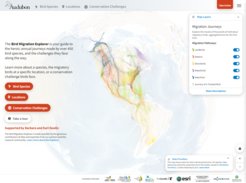A powerful picture
Movebank partners with Audubon on a cutting-edge visual resource for conserving migratory birds
We are living in a golden age of migration tracking technology and research. A first-of-its-kind platform from the National Audubon Society brings together the results of this work to offer an interactive view of bird migrations across the Americas. The Bird Migration Explorer draws together an unprecedented amount of data to visualize the migratory routes of 458 species of migratory birds found in the western hemisphere. Movebank—the animal tracking database from the Max Planck Institute of Animal Behavior (MPI-AB)—is one of ten partners that helped turn this vision into the new online atlas, which visualizes the incredible journeys of migratory birds, how they connect us, as well as the challenges they face.

"Scientists have discovered so much about bird migration through animal tracking, but the results are scattered across hundreds of projects and research papers,” says Sarah Davidson, Movebank’s data curator and principal investigator. “We have been thrilled to help the Bird Migration Explorer bring these movements together with other data and see what they can tell us.”
Harnessing tracking data
For the first time, the Bird Migration Explorer draws together a range of data types—abundance data, connectivity data, tracking data, and environmental and infrastructure data—and visualises them on maps to create a complete picture of migration for bird species in the Americas.
For the tracking data, the National Audubon Society's Migratory Bird Initiative partnered with Movebank to help harness the vast amounts of bird movement data recorded by animal-borne sensors. As a global database for animal movement data, Movebank provided a central place to discover, store, and access bird migration data for use in the Bird Migration Explorer. Researchers wishing to share tracking data with the initiative could do so through Movebank, thus making it accessible to the Audubon mapping team. In total, Audubon accessed tracking data for more than 100 species through Movebank.
A goal of Movebank is to help scientists and groups like Audubon to connect with each other and initiate new projects. “Our role was to help researchers put their data on Movebank so they could participate in the initiative and to help the mapping team use Movebank's API to automate data access,” says Davidson.
All maps produced for the Bird Migration Explorer include a citation to the original data providers. Users can locate the original study on Movebank along with additional information on how, when, and why the data were collected, and contact the data owners with questions.
"These tracking data represent a massive effort by hundreds of people, developing cutting-edge technology and getting out in the field to safely attach tags to wild birds," Davidson says. "It's important to credit this work and to help people understand how these data were collected and used to support scientific research and conservation."
Bird Migration Explorer: Explained
Cutting-edge resource
Since 1970, North America has lost more than 2.5 billion migratory birds. This devastating trend was the impetus for Audubon to partner with ten organisations to provide bird enthusiasts, scientists, and policy-makers with a glimpse into the movements of migratory birds and what is needed to protect them.
To achieve this goal, and to consolidate the various data types in one place, the team behind the Bird Migration Explorer split the visualisations into three map types. These maps are derived from millions of re-encounter observations from tracking, banding, automated radio telemetry, and genetics data.
Migration maps, which overlay tracking data on abundance data, show the movements of 458 species of migratory birds that regularly occur in the United States and Canada as they travel throughout the hemisphere to complete their annual cycle.
Connections maps show where tagged individuals of one species have been re-encountered as they traveled across the hemisphere.
Finally the conservation maps illustrate where migratory birds are exposed to 19 human-induced threats–from wind turbines to light pollution.
Over 10 years ago, Martin Wikelski, MPI-AB director, founded Movebank with Roland Kays from North Carolina State University. Their goal was to create a platform for comparing and storing animal movement data collected by animal-borne sensors. He says that the Bird Migration Explorer takes an important step by offering a single user-friendly tool for exploring the global movements of some of Earth’s most intrepid travellers–birds–and how they connect populations and ecosystems across the planet.
In doing so, Wikelski says it also provides a scientific basis for necessary conservation policies and solutions to address the steep declines of migratory birds. “With these striking visualizations, we can discover birds and their migrations, connect them to our home towns, and learn how to help conserve them for future generations."













